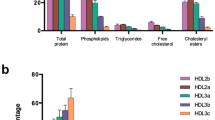Abstract
Low density lipoprotein (LDL) and lipoprotein(a) suppress catecholamine secretion in cultured adrenal medullary cells. Modification of LDL by oxidation or acetylation potentiates various atherogenic actions of LDL. In the present study, we investigated whether the modification of LDL influences catecholamine secretion in cultured bovine adrenal medullary cells. The exposure of LDL to CuSO4 caused a time-dependent oxidation of LDL. Maximal oxidation of LDL was observed after exposure to CuSO4 for 24 h. Native LDL inhibited catecholamine secretion induced by carbachol to 68.5% of control. Oxidized LDL caused further inhibition of carbachol-evoked secretion to 37.6% of control. Acetylated LDL inhibited it to 41.0% of control. There was a good correlation between the extent of LDL oxidation and the inhibition of catecholamine secretion. These results suggest that oxidation or acetylation of LDL augments its inhibitory effect on the secretion of catecholamines. Since catecholamines are a risk factor of atherosclerosis, the inhibitory effect by such modified LDL may be a mechanism inhibiting atherosclerotic progression.
Similar content being viewed by others
Author information
Authors and Affiliations
Additional information
Received: 29 January 1999 / Accepted: 19 April 1999 / Published online: 22 June 1999
Rights and permissions
About this article
Cite this article
Kajiwara, K., Yanagihara, N., Ioka, T. et al. Modification of low density lipoprotein potentiates its inhibitory effect on catecholamine secretion in cultured bovine adrenal medullary cells. Naunyn-Schmiedeberg's Arch Pharmacol 360, 99–102 (1999). https://doi.org/10.1007/s002109900039
Issue Date:
DOI: https://doi.org/10.1007/s002109900039




